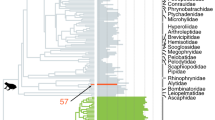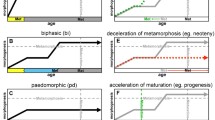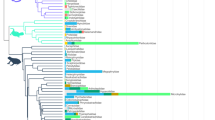Abstract
Facultative traits can provide phenotypic lability in dynamic environments, but it is unclear how weaving between disparate habitats impacts non-facultative traits that are carried along the way. The life cycles of salamanders are associated with distinct ontogenies, aquatic-to-terrestrial (biphasic), completely-terrestrial (direct development), and completely-aquatic (larval form paedomorphic). Salamanders have some of the largest genomes among vertebrates, and the most extreme expansions have been attributed to paedomorphosis and life cycle simplification. Recent analyses of genome size evolution across amphibians have rejected this hypothesis for salamanders. Our analyses show that treatment of facultatively paedomorphic salamanders, which are alternatively biphasic, in part explains this discrepancy. Nearly all of the facultatively paedomorphic species analyzed have genome sizes that overlap with the optimum of biphasic species. We found that obligate paedomorphs, alone and when combined with direct developers, have significantly larger genome sizes than biphasics plus facultative paedomorphs. In general, salamander genome size variation fits life cycle models better than those for larval ecology, adult ecology, or aquatic habitat stability. Obligate transitions to a simple life cycle appear to have been an important route for lineages to evolve significant divergence in genome size from biphasic ancestors. Our analyses support the classic association between genome size variation and life cycle complexity in salamanders, which may ultimately reflect patterns of time limited development.




Similar content being viewed by others
References
Adams, D. C., & Collyer, M. L. (2018). Phylogenetic ANOVA: GROUP-clade aggregation, biological challenges, and a refined permutation procedure. Evolution,72, 1204–1215.
Arnold, S. J. (2014). Phenotypic evolution: The ongoing synthesis. American Naturalist,183, 729–746.
Beaulieu, J. M., Jhwueng, D. C., Boettiger, C., & O’Meara, B. C. (2012). Modeling stabilizing selection: Expanding the Ornstein-Uhlenbeck model of adaptive evolution. Evolution,66, 2369–2383.
Beaulieu, J. M., Leitch, I. J., Patel, S., Pendharkar, A., & Knight, C. A. (2008). Genome size is a strong predictor of cell size and stomatal density in angiosperms. New Phytologist,179, 975–986.
Bonett, R. M. (2016). An integrative endocrine model for the evolution of developmental timing and life history of plethodontids and other salamanders. Copeia,104, 209–221.
Bonett, R. M. (2018). Heterochrony. In L. Nuño de la Rosa & G. B. Müller (Eds.), Evolutionary developmental biology (pp. 1–14). New York: Springer.
Bonett, R. M., Trujano-Alvarez, A. L., Williams, M. J., & Timpe, E. K. (2013). Biogeography and body size shuffling of aquatic salamander communities on a shifting refuge. Proceedings of the Royal Society B,280, 20130200.
Bonett, R. M., Steffen, M. A., & Robison, G. A. (2014). Heterochrony repolarized: A phylogenetic analysis of developmental timing in plethodontid salamanders. EvoDevo,5, 27.
Bonett, R. M., & Blair, A. L. (2017). Evidence for complex life cycle constraints on salamander body form diversification. Proceedings of the National Academy of Sciences USA,114, 9936–9941.
Bonett, R. M., Phillips, J. G., Ledbetter, N. M., Martin, S. D., & Lehman, L. (2018). Rapid phenotypic evolution following shifts in life cycle complexity. Proceedings of the Royal Society B: Biological Sciences,285, 20172304.
Bouckaert, R., Heled, J., Kühnert, D., Vaughan, T., Wu, C.-H., Xie, D., et al. (2014). BEAST 2: A software platform for bayesian evolutionary analysis. PLoS Computational Biology,10, e1003537.
Burnham, K., & Anderson, D. (2002). Model selection and multi-model inference: A practical information theoretic approach (2nd ed.). New York: Springer.
Butler, M. A., & King, A. A. (2004). Phylogenetic comparative analysis: A modeling approach for adaptive evolution. American Naturalist,164, 683–695.
Cavalier-Smith, T. (1991). Coevolution of vertebrate genome, cell, and nuclear sizes. In G. Ghiara (Ed.), Symposium on the evolution of terrestrial vertebrates (pp. 51–86). Mucchi: Modena.
Chippindale, P. T., Bonett, R. M., Baldwin, A. S., & Wiens, J. J. (2004). Phylogenetic evidence for a major reversal of life-history evolution in plethodontid salamanders. Evolution,58, 2809–2822.
Collyer, M. L., & Adams, D. C. (2018). RRPP: An R package for fitting linear models to high-dimensional data using residual randomization. Methods in Ecology and Evolution,9, 1772–1779.
Das, B., Cai, L., Carter, M. G., Piao, Y.-L., Sharov, A. A., Ko, M. S., et al. (2006). Gene expression changes at metamorphosis induced by thyroid hormone in Xenopus laevis tadpoles. Developmental Biology,291, 342–355.
Denoël, M., & Ficetola, G. F. (2014). Heterochrony in a complex world: Disentangling environmental processes of facultative paedomorphosis in an amphibian. Journal of Animal Ecology,83, 606–615.
Denoël, M., & Joly, P. (2001). Adaptive significance of facultative paedomorphosis in Triturus alpestris (Amphibia, Caudata): Resource partitioning in an alpine lake. Freshwater Biology,46, 1387–1396.
Denoël, M., Joly, P., & Whiteman, H. H. (2005). Evolutionary ecology of facultative paedomorphosis in newts and salamanders. Biological Review,80, 663–671.
Dodsworth, S., Guignard, S., Hidalgo, O., Leitch, I. J., & Pellicer, J. (2016). Digests: Salamanders ’ slow slither into genomic gigantism. Evolution,70, 2915–2916.
Duellman, W. E., & Trueb, L. (1994). Biology of amphibians. Baltimore: JHU press.
Dumont, E. R., Da, L. M., Goldberg, A., Santana, S. E., Rex, K., & Voigt, C. C. (2012). Morphological innovation, diversification and invasion of a new adaptive zone. Proceedings of the National Academy of Sciences USA,279, 1797–1805.
Estes, S., & Arnold, S. J. (2007). Resolving the paradox of stasis: Models with stabilizing selection explain evolutionary divergence on all timescales. American Naturalist,169, 227–244.
Etheridge, K. (1990). The energetics of estivating sirenid salamanders (Siren lacertina and Pseudobranchus striatus). Herpetologica,46, 407–414.
Felsenstein, J. (1985). Phylogenies and the comparative method. American Naturalist,125, 1–15.
Futuyma, D. J. (2010). Evolutionary constraint and ecological consequences. Evolution,64, 1865–1884.
Goin, O. B., Goin, C. J., & Bachmann, K. (1968). DNA and amphibian life history. Copeia,1968, 532–540.
Gregory, T. R. (2001). The bigger the C-value, the larger the cell: Genome size and red blood cell size in vertebrates. Blood Cells, Molecules and Diseases,27, 830–843.
Gregory, T. R. (2002a). A bird’s-eye view of the C-value enigma: Genome size, cell size, and metabolic rate in the class Aves. Evolution,56, 121–130.
Gregory, T. R. (2002b). Genome size and developmental complexity. Genetica,115, 131–146.
Gregory, T. R. (2005). The evolution of the genome. Amsterdam: Elsevier.
Gregory, T. R. (2019). Animal genome size database. https://www.genomesize.com.
Grime, J. P. (1982). Variation in genome size-an ecological interpretation. Nature,299, 151–153.
Hanken, J. (1992). Life history and morphological evolution. Journal of Evolutionary Biology,5, 549–557.
Janson, E. M., Stireman, J. O., III, Singer, M. S., & Abbot, P. (2008). Phytophagous insect—Microbe mutualisms and adaptive evolutionary diversification. Evolution,62, 997–1012.
Jockusch, E. L. (1997). An evolutionary correlate of genome size change in plethodontid salamanders. Proceedings of the Royal Society B: Biological Sciences,264, 597–604.
Lande, R. (1980). Genetic variation and phenotypic evolution during allopatric speciation. American Naturalist,116, 463–479.
Ledbetter, N. M., & Bonett, R. M. (2019). Terrestriality constrains salamander limb diversification: Implications for the evolution of pentadactyly. Journal of Evolutionary Biology,32, 1–11.
Lertzman-Lepofsky, G., Mooers, A. Ø., & Greenberg, D. A. (2019). Ecological constraints associated with genome size across salamander lineages. Proceedings of the Royal Society B,286, 20191780.
Licht, L. E., & Lowcock, L. A. (1991). Genome size and metabolic rate in salamanders. Comparative Biochemistry and Physiology,100B, 83–92.
Liedtke, H. C., Gower, D. J., Wilkinson, M., & Gomez-Mestre, I. (2018). Macroevolutionary shift in the size of amphibian genomes and the role of life history and climate. Nature Ecology & Evolution,2, 1792–1799.
Losos, J. B., Warheitt, K. I., & Schoener, T. W. (1997). Adaptive differentiation following experimental island colonization in Anolis lizards. Nature,387, 70–73.
Lynch, M., & Conery, J. S. (2003). The origins of genome complexity. Science,302, 1401–1405.
Martin, C., & Gordon, R. (1995). Differentiation trees, A junk DNA molecular clock, and the evolution of neoteny in salamanders. Journal of Evolutionary Biology,8, 339–354.
Moczek, A. P., Sultan, S., Foster, S., Ledon-Rettig, C., Dworkin, I., Nijhout, H. F., et al. (2011). The role of developmental plasticity in evolutionary innovation. Proceedings of the Royal Society of London B,278, 2705–2713.
Mohlhenrich, E. R., & Mueller, R. L. (2016). Genetic drift and mutational hazard in the evolution of salamander genomic gigantism. Evolution,70, 2865–2878.
Mueller, R. L. (2015). Genome biology and the evolution of cell-size diversity. Cold Spring Harbor Perspectives in Biology,7, a019125.
Mueller, R. L., & Jockusch, E. L. (2018). Jumping genomic gigantism. Nature Ecology & Evolution,2, 1687.
Mueller, R. L., Macey, J. R., Jaekel, M., Wake, D. B., & Boore, J. L. (2004). Morphological homoplasy, life history evolution, and historical biogeography of plethodontid salamanders inferred from complete mitochondrial genomes. Proceedings of the National Academy of Sciences USA,101, 13820–13825.
O’Meara, B. C., Ane, C., Sanderson, M. J., & Wainwright, P. C. (2006). Testing for different rates of continuous trait evolution using likelihood. Evolution,60, 922–933.
Ovaska, K., & Estrada, A. R. (2003). Eleutherodactylus antillensis (Coquí Churí).Reproduction. Herpetological Review,34, 229.
Paradis, E., Claude, J., & Strimmer, K. (2004). APE: Analyses of phylogenetics and evolution in R language. Bioinformatics,20, 289–290.
Pfennig, D., Wund, M. A., Snell-Rood, E. C., Cruickshank, T., Schlichting, C. D., & Moczek, A. P. (2010). Phenotypic plasticity’s impacts on diversification and speciation. Trends in Ecology and Evolution,25, 459–467.
Pinheiro, J., Bates, D., DebRoy, S., & Sarkar, D. R Core Team. (2019). nlme: Linear and nonlinear mixed effects models. R package version 3.1–143, https://CRAN.R-project.org/package=nlme.
Revell, L. J. (2012). phytools: An R package for phylogenetic comparative biology (and other things). Methods in Ecology and Evolution,3, 217–223.
Row, J. R., Donaldson, M. E., Longhi, J. N., Saville, B. J., & Murray, D. L. (2016). Tissue-specific transcriptome characterization for developing tadpoles of the northern leopard frog (Lithobates pipiens). Genomics,108, 232–240.
Sanchez, E., Küpfer, E., Goedbloed, D. J., et al. (2018). Morphological and transcriptomic analyses reveal three discrete primary stages of postembryonic development in the common fire salamander, Salamandra salamandra. Journal of Experimental Zoology (Mol Dev Evol),330, 96–108.
Schwarz, G. (1978). Estimating the dimension of a model. Annals of Statistics,6, 461–464.
Sessions, S. K. (2008). Evolutionary cytogenetics in salamanders. Chromosome Research,16, 183–201.
Sessions, S. K., & Larson, A. (1987). Developmental correlates of genome size in plethodontid salamanders and their implications for genome evolution. Evolution,41, 1239–1251.
Shi, Y.-B. (2000). Amphibian metamorphosis. Hoboken: Wiley.
Simpson, G. G. (1944). Tempo and mode in evolution. New York: Columbia University Press.
Simpson, G. G. (1953). The major features of evolution. New York: Columbia University Press.
Slatkin, M. (1987). Gene flow and the geographic structure of natural populations. Science,236, 787–792.
Smith, M. E., & Secor, S. M. (2017). Physiological responses to fasting and estivation for the Three-Toed Amphiuma (Amphiuma tridactylum). Physiological and Biochemical Zoology,90, 240–256.
Starostova, Z., Kubička, L., Konarzewski, M., Kozłowski, J., & Kratochvíl, L. (2009). Cell size but not genome size affects scaling of metabolic rate in eyelid geckos. American Naturalist,174, E100–105.
Sun, C., López Arriaza, J. R., & Mueller, R. L. (2012). Slow DNA loss in the gigantic genomes of salamanders. Genome Biology and Evolution,4, 1340–1348.
Sun, C., & Mueller, R. L. (2014). Hellbender genome sequences shed light on genomic expansion at the base of crown salamanders. Genome Biology and Evolution,6, 1818–1829.
Szarski, H. (1983). Cell size and the concept of wasteful and frugal evolutionary strategies. Journal of Theoretical Biology,105, 201–209.
Team, R. C. (2018). R: A language and environment for statistical computing. Austria: R Foundation for Statistical Computing Vienna.
Thomas, G. H., Freckleton, R. P., & Szekely, T. (2006). Comparative analysis of the influence of developmental mode on phenotypic diversification rates in shorebirds. Proceedings of the Royal Society B,273, 1619–1624.
Thompson, K. (1990). Genome size, seed size and germination temperature in herbaceous angiosperms. Evolutionary Trends in Plants,4, 113–116.
Uyeda, J. C., Hansen, T. F., Pienaar, J., & Arnold, S. J. (2011). The million-year wait for macroevolutionary bursts. Proceedings of the National Academy of Sciences USA,108, 15908–15913.
Uyeda, J. C., Pennell, M. W., Miller, E. T., Maia, R., & McClain, C. R. (2017). The evolution of energetic scaling across the vertebrate tree of life. American Naturalist,190, 185–199.
Van Valen, L. (1971). Adaptive zones and the orders of mammals. Evolution,25, 420–428.
Vinogradov, A. E. (1997). Nucleotypic effect in homeotherms: Body-mass independent resting metabolic rate of passerine birds is related to genome size. Evolution,51, 220–225.
Vinogradov, A. E. (1995). Nucleotypic effect in homeotherms: Body-mass-corrected basal metabolic rate of mammals is related to genomic size. Evolution,49, 1249–1259.
Wagner, G. P., & Altenberg, L. (1996). Perspective: Complex adaptations and the evolution of evolvability. Evolution,50, 967–976.
Wagner, L. A. (2014). Life history variables of Dicamptodon salamanders. Oregon State University.
Wake, D. B., & Marks, S. B. (1993). Development and evolution of plethodontid salamanders: A review of prior studies and a prospectus for future research. Herpetologica,49, 194–203.
Wells, K. D. (2010). The ecology and behavior of amphibians. Chicago: University of Chicago press.
West-Eberhard, M. J. (1989). Phenotypic plasticity and the origins of diversity. Annual Review of Ecology and Systematics,20, 249–278.
West-Eberhard, M. J. (2005). Developmental plasticity and the origin of species differences. Proceedings of the National Academy of Sciences USA,102, 6543–6549.
Whiteman, H. H. (1994). Evolution of facultative paedomorphosis in salamanders. Quarterly Review of Biology,69, 205–221.
Wollenberg Valero, K., Garcia-Porta, J., Rodríguez, A., et al. (2017). Transcriptomic and macroevolutionary evidence for phenotypic uncoupling between frog life history phases. Nature Communications,8, 15213.
Womack, M. C., Metz, M. J., & Hoke, K. L. (2019). Larger genomes linked to slower development and loss of late-developing traits. American Naturalist,194, 854–864.
Acknowledgements
We thank B. Hallgrimsson and an anonymous reviewer for comments on the manuscript. We also thank M. Collyer for verifying our RRPP phyloANOVA code. Funding for this research was provided in part by the University of Tulsa, and the National Science Foundation (DEB 1050322 and DEB 1840987) to RMB.
Author information
Authors and Affiliations
Corresponding author
Ethics declarations
Conflict of interest
The authors declare that we have no conflict of interest with regards to this research.
Research Involving Human and Animal Rights
This study did not directly involve live animals or experiments.
Electronic supplementary material
Below is the link to the electronic supplementary material.
Rights and permissions
About this article
Cite this article
Bonett, R.M., Hess, A.J. & Ledbetter, N.M. Facultative Transitions Have Trouble Committing, But Stable Life Cycles Predict Salamander Genome Size Evolution. Evol Biol 47, 111–122 (2020). https://doi.org/10.1007/s11692-020-09497-8
Received:
Accepted:
Published:
Issue Date:
DOI: https://doi.org/10.1007/s11692-020-09497-8




